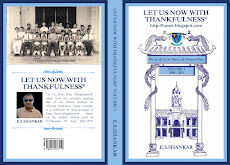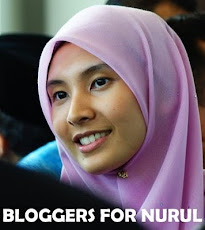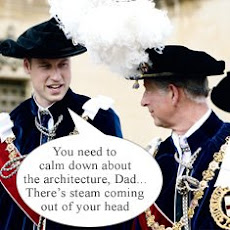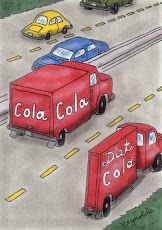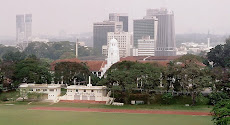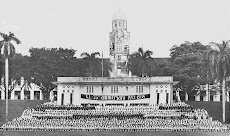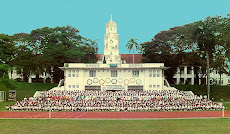a rose by any other name
Kuala Lumpur or ‘Mud of the Estuary’ at the confluence of the Gombak and Klang rivers does not sound a very exotic or thrilling name. Unlike say, Rio de Janeiro. The name is not pretty, like Osaka, or historic and ancient, like Cairo or Rome. No, its forefathers could have done a lot better. Babylon! Now there’s an exotic name to conjure up visions of greatness, magic, mystery and excitement. Nebuchadnezzar of the Hanging Gardens. Nimrod of the Tower of Babel.
But then they say civilization began at the confluence of two rivers, the Tigris and Euphrates which flow through Iraq.
There is, therefore, divinity in mud and in its ooze and slime. Therein lies Kuala Lumpur's greatness. All agree that life began from a kind of mud-slime. According to Hindu legends, the mystery of creation and the history of pisces, amphibian, avian, animal, proto-man and human lie buried deeply in The Dasavatharam, the ten most popular avatars of Lord Vishnu:
Matsya (fish), Kurma (tortoise, amphibious,), Varaha (Wild Boar, avian, land beast), Narasimha (beast-man-god), Vamana (boy-Man), Parasurama (anti-warrior Man), Sri Rama (righteous Man), Sri Krishna (intellectual Man), Buddha (self-realised Man) and Kalki (destroyer and dissolution Man).
Kuala Lumpur. What’s in a name? A rose by any other name smells just as sweet!
chasing the dragon
In his 1821 ‘Confessions of an English Opium Eater’ Thomas de Quincey traces his addiction to his first innocent purchase of a ‘tincture of Opium.’ An acquaintance had recommended that he buy it from a pharmacy in Oxford Street, London. The druggist had describes it as ‘unconscious minister of celestial pleasures.’ Quincey had only wanted something to ease a combination of gastric, tooth and rheumatic pains and aches. Instead, he discovers a panacea and experiences a ‘high’ the fantastic delightful likes of which he has never before experienced. Being the honest intellectual that he is, Quincey goes on to describe in some length and detail the horror and nightmare of drug addiction.
Aldous Huxley, the Oxford educated author of ‘Brave New World’ wanted to go beyond the normal perception levels of the human brain. Huxley made a case that the creative output from writers, artists and scientists could be revived and enhanced especially when they hit a ‘wall’ in their careers. Huxley’s personal experiences under controlled conditions are recounted in his ‘Doors of Perception’ and ‘Heaven and Hell.’ He had experimented with hallucinogenic drugs such as Mescaline.
Carlos Castaneda’s purported experiences with Don Juan, a Yaqui Indian shaman who introduces him to peyote, mescaline, had better be true. Otherwise he is a prime candidate for strait-jacket and asylum. He describes flights through time and dimensions and encounters with unheard of strange creatures and beings. His accounts are the most fantastic of modern times.
However, it would be a mistake to conclude that experimentation with drugs for recreation and mind enhancement purposes are new ideas.
King Puru who was instrumental in the unwinding of the Mahabharatha, was a descendant of Soma, son of Prajapati Atri. Soma was the founder of the Moon or Chandra Dynasty. But Soma was also the immortality-giving drink of the Devas of India as well as Iran! It was synthesized in ancient times possibly from psychedelic mushrooms. The Rishis of the Vedas and Upanishads were known to drink Soma to lift their consciousness and meditation levels to new heights. The effects of Soma increased when consumed during the full moon period!
So, are these claims by Quincey, Huxley, Castaneda and the Vedas really all that wild?
What then gave the impetus for Portuguese, Dutch and British trade in opium and the smuggling of it to China in the 1800’s? They were certainly not anchored on lofty ideals of scientific curiosity or achieving significantly fresh break-through in writing, the humanities or science. No sirree! It was based on pure greed. Simple selfish Economic motives.
China was a rich source of silk, jade, porcelain, spices and tea. The insatiable appetite of Europe and Britain for these commodities led to a huge deficit in balance of trade in favour of China. Settlement of the deficit was in silver which the British found getting scarcer and scarcer.
At this juncture, I pose a fair question. What would the reaction be today should Colombia suggest Britain takes Heroin to settle a huge balance of trade deficit between the two countries, serviced by the Medellin Cartel with perhaps some assistance from Taliban terrorists to even out their economic problems? Could we perhaps envisage riots in the streets of London followed by a United Nations Security Council resolution for Trade Embargo against Colombia?
Well, this is the irresistible irrefusable offer that the British Consiglieri stuffed in a suckling pig’s head with apple in mouth and trimmings and all and slipped into the Qin (pronounced 'Chin') Emperor's bed in 1834. Take Opium or take Opium!
The Chinese knew a thing or two about the little poppy seed ever since the early 16th century when Opium dens sprung up in Canton (now Guandong) and Shanghai. About how, once addicted to Opium it was only a matter of time before post-graduate experimentation would began in ‘chasing the dragon.’ They had shed rivers of tears over the debilitating effect opium had on individuals, families and society as a whole. It was therefore totally unsurprising that after two hundred years of abuse, the Qin Emperor of the Manchu Dynasty banned opium in 1729.
But the British continued to encourage the smuggling of Opium to China from India as though it didn’t matter. Their attitude seemed to be ‘After all we rule the waves. It’s your bitch. You deal with it!’ or something like that!
The Two Opium Wars between China and Britain between 1834 -1860 and The Taiping Wars saw the decline of the mighty 4,000 year old Chinese monarchy. They were undone by Britain, France and Russia to the point in 1911 when the Chinese monarchy was completely destroyed. Never mind how many million Chinese were killed in the process. The British, I suspect, had more than just business motives and tea in mind although that’s what Lord Ha Ha or whoever, wrote.
Yap Ah Loy a.k.a. Yap Tet Loy, a Hakka member of the Hai San Triad and son of a peasant was born on 14th March 1837 in Canton. Ah Loy, who never attended school, left China for Melaka in 1854, having learnt one important lesson from the British.
‘
There’s Gold in them there Poppy hills!’
the opium trail
‘You see ah, there’s this great dambig invisible dragon which has its fire-breathing mouth facing Genting Highland. Which explain why the flow of money at the casino never stop one. The tail and backside of the dragon is howrever resting in Ampang Valley. Now you know why we have so many landslide one, especially the Highland Towers tragedy. The Feng Shui is very bad, very very bad for Ampang. You dontch belief, this very scientific one.’
Hindsight is always 20:20, never mind the Manglish!
But then this Ampang, meaning a dam or bund to divert water for irrigation, in the Hulu Langat district of the state of Selangor is where it all began in 1857.
Raja Abdullah bin Raja Jaafar who had Bugis roots from Riau in Sumatra gave tin mining rights in the jungles of Ampang to 87 Hakka Chinese. Sixty-nine of them died from malaria within a year. Klang Valley as such did not exist then. But Kuala Lumpur or KL which started as a frontier town from Ampang did not look back, driven forward by world demand for tin. British presence in the west coast states of Malaya was already quite pervasive. They recognised a bonanza when they smelled one and needed an intermediary to deal with the Sultan of Selangor, his chiefs and the Chinese miners. Hiu Siew, a diplomat cum godfather figure was appointed the first Kapitan China of KL by the British.
The busy Raja Abdullah also leased Klang to W.H. Read and Tan Kim Ching who as a result automatically secured rights over tax collections. Raja Mahdi, son of the previous administrator of Klang, justifiably refused to recognise any encroachment by foreigners on his territory. His prompt declaration of war was tacitly supported by the incumbent Sultan Abdul Samad.
After several failures and near-bankruptcy in Melaka, Yap Ah Loy made his way up to Sungai Ujong and Lukut in Selangor in 1856. He worked there as a kitchen help in a tin-mine. Soon he rose to the position of head fighter or Kung Fu Si Fu (Kung Fu Enforcer) under the second Kapitan China, Liu Ngim Kong. In 1868, age 31, Yap Ah Loy, through sheer industriousness, succeeded as the third Kapitan China of KL.
When civil war broke out in Selangor in 1870 there were two clear factions. Mahdi and his chiefs stood on one side and Raja Abdullah, Yap Ah Loy and Tengku Kudin on the other. The Tengku was a Kedah prince who had married into the Selangor royal family. He counted as his friend Andrew Clark, the Governor of the Straits Settlement. Ah Loy also locked horns with Chong Chong who had an eye on the Kapitan China’s lucrative post. British might combined with Ah Loy’s battle savvy warriors inflicted a crushing blow on Mahdi and his forces in 1874. Mahdi fled to Johor. But Sultan Samad did not see eye to eye with Tengku Kudin and froze him out.
The British were only able get a firm foothold in Selangor in November 1875. Sultan Samad himself consented to the appointment of JG Davidson as the first British Resident of Selangor. This had less to do with any genuine affection for the British and more to do with securing protection from marauding Sumatran pirates.
Yap Ah Loy passed away on 1st September 1884 after a very successful tenure as the greatest Kapitan China in Malaya.
The crucial question is of course, who founded Kuala Lumpur?
‘Founded’ must be just about the most misused English word when applied in conjunction with ‘History.’ Did Francis Light really ‘found’ Penang when the presence of native Malay settlers was evident centuries before 1786? Or Stamford Raffles, Singapore in 1819, when ‘Singapura’ was recorded in the 1612 Sejarah Melayu and ‘Temasik’ in earlier Ming records? Or Columbus, America, when he never set foot on mainland USA and there were native Indians in San Salvador, Cuba and Colombia? And what about Cook and Australia when the Australian Aborigine has been criss-crossing his ‘Dream Time' world for over 30,000 years!
Raja Abdullah and Yap Ah Loy both have a legitimate claim. Possibly, even Sultan Samad for being the power on the throne. This is thrown into further confusion with a claim staked by Sutan Puasa from Sumatra. He led the Mandailing of Acheh who had their own language and writing. The Mandailing, now largely absorbed into the Malay community, had originally settled in the 1800’s in Papan, Perak. Puasa claimed that had sent Hiu Siew and Ah Sze Keldek, the first Chinese tin traders and miners, to Ampang.
We have to keep matters in perspective. Ah Loy was the third Kapitan China of KL, not the first. A large measure of Don Ah Loy’s skills lay in expertise acquired as a member of the Hai San Triad. He not only ensured frontier-style but effective justice, peace and order among the 10,000 Chinese of various ethnicities and clans in KL. He also guaranteed safe passage for the transport of tin ore down the Klang River by sampan and barges for export. However, the usual Triad menu of money-lending, gambling, alcohol, protection, prostitution and monopoly on opium and opium dens were on offer as well. It was not unknown for some members of the Malay royalty of those days to occasionally while away their leisure hours in YAL’s opium dens such being the case in Larut as well.
This is not to suggest that Ah Loy slipped everything into his back pocket. The first Chinese school in KL was built in High Street in 1884. The grand Sin Sze Si Ya Temple was erected in Jalan Hang Kasturi. The first steam pump was introduced to Malaya. All these owed much to Ah Loy’s philanthropy and foresight. He developed land and owned perhaps a quarter of all the buildings in KL then.
He was mainly responsible for the stunning recovery of the Tin Mining industry after the civil war. When KL burned down in 1881 he chipped in with the lion’s share to the rebuilding of it. He contributed immensely to the rapid growth of the commercial metropolis. In this he was also aided by Thamboosamy Pillay, his business partner Yap Ah Shak and the last Kapitan China, Yap Kwan Seng, after all of whom roads have been named in KL.
Thamboosamy was a founder of Victoria Institution, a school built in 1893 to commemorate Queen Victoria’s Jubilee Year celebrations. He also developed the modern tourist attractions of Batu Caves and the Maha Mariamman Temple.
Yap Ah Loy had a vision for KL the two previous Kapitan China, and possibly the rest of Selangor as well, did not have an inkling to.
At worse, Raja Abdullah can be granted the title of ‘Founder of Kuala Lumpur.’ But history books written by our very own Malaysian historians in an era when they had no axe to grind, and before over-zealous exuberance set in, had given Ah Loy that title. So, perhaps in true Malaysian spirit and style YAL and RA, joint founders lah? Win-Win paradigm shift compromise? After all, YAL re-built the fire-razed KL?
But to leave Yap Ah Loy’s name completely out of history books?
That would be akin to the omission of Einstein’s name from Relativity in America on the grounds that he came from Nazi Germany. A heresy that could only be compounded by those who claim students are bored with History and confused by too many dates, facts and names in textbooks. That to make History interesting only the essential, concise and compressed ‘true facts’ would be stated. True Facts? A classic example of tautology if ever there was one, which even our learned judges and leading lawyers indulge in!
Does the past really matter? Should revisionist historians be permitted to write whatever they like? After all most of us can’t write or read the England proper any more?
Hell, it does, and like hell they will! Let’s start again as it once did with:
‘In 1400, Parameswara, a Hindu prince whose ancestry was Indian, Malay and Aborigine, fled Palembang in Sumatra, Indonesia when attacked by the Majapahit Empire…..made his way to Singapore…and finally settled in Melaka named after….established the Melaka Sultanate which heralded the Golden Age of Melaka. ….provided the impetus for the spread of Islam in South East Asia. …..Yap Ah Loy, an uneducated Chinese immigrant from Canton in China…..founded Kuala Lumpur after Raja Abdullah boldly sent 87 Chinese miners........’
For surely, there would have been no Kuala Lumpur without the riches and fame of Melaka where Yap Ah Loy first landed on our shores!
The rest, as they say, is HISTORY!
Now, that wasn’t difficult or painful, was it?
The truth never is!
Kuala Lumpur would then stand as a testament to the search for truth, everywhere! It would be universally worshipped and respected for the most noble of aspirations. Truth!
That’s the Kuala Lumpur I grew up in!
Kuala Lumpur, Federal capital of Malaysia. What’s in a name? A rose by any other name smells just as sweet!















